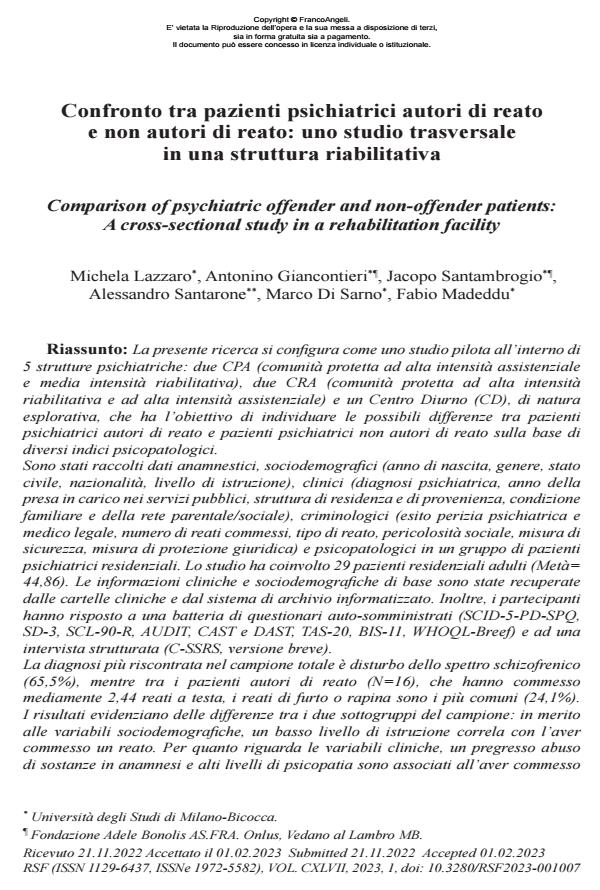Confronto tra pazienti psichiatrici autori di reato e non autori di reato: uno studio trasversale in una struttura riabilitativa
Titolo Rivista RIVISTA SPERIMENTALE DI FRENIATRIA
Autori/Curatori Michela Lazzaro, Antonino Giancontieri, Jacopo Santambrogio, Alessandro Santarone, Marco Di Sarno, Fabio Madeddu
Anno di pubblicazione 2023 Fascicolo 2023/1
Lingua Italiano Numero pagine 21 P. 103-123 Dimensione file 213 KB
DOI 10.3280/RSF2023-001007
Il DOI è il codice a barre della proprietà intellettuale: per saperne di più
clicca qui
Qui sotto puoi vedere in anteprima la prima pagina di questo articolo.
Se questo articolo ti interessa, lo puoi acquistare (e scaricare in formato pdf) seguendo le facili indicazioni per acquistare il download credit. Acquista Download Credits per scaricare questo Articolo in formato PDF

FrancoAngeli è membro della Publishers International Linking Association, Inc (PILA)associazione indipendente e non profit per facilitare (attraverso i servizi tecnologici implementati da CrossRef.org) l’accesso degli studiosi ai contenuti digitali nelle pubblicazioni professionali e scientifiche
La presente ricerca si configura come uno studio pilota all’interno di 5 strutture psichiatriche: due CPA (comunità protetta ad alta intensità assistenziale e media intensità riabilitativa), due CRA (comunità protetta ad alta intensità riabilitativa e ad alta intensità assistenziale) e un Centro Diurno (CD), di natura esplorativa, che ha l’obiettivo di individuare le possibili differenze tra pazienti psichiatrici autori di reato e pazienti psichiatrici non autori di reato sulla base di diversi indici psicopatologici. Sono stati raccolti dati anamnestici, sociodemografici (anno di nascita, genere, stato civile, nazionalità, livello di istruzione), clinici (diagnosi psichiatrica, anno della presa in carico nei servizi pubblici, struttura di residenza e di provenienza, condizione familiare e della rete parentale/sociale), criminologici (esito perizia psichiatrica e medico legale, numero di reati commessi, tipo di reato, pericolosità sociale, misura di sicurezza, misura di protezione giuridica) e psicopatologici in un gruppo di pazienti psichiatrici residenziali. Lo studio ha coinvolto 29 pazienti residenziali adulti (Metà= 44,86). Le informazioni cliniche e sociodemografiche di base sono state recuperate dalle cartelle cliniche e dal sistema di archivio informatizzato. Inoltre, i partecipanti hanno risposto a una batteria di questionari auto-somministrati (SCID-5-PD-SPQ, SD-3, SCL-90-R, AUDIT, CAST e DAST, TAS-20, BIS-11, WHOQL-Breef) e ad una intervista strutturata (C-SSRS, versione breve). La diagnosi più riscontrata nel campione totale è disturbo dello spettro schizofrenico (65,5%), mentre tra i pazienti autori di reato (N=16), che hanno commesso mediamente 2,44 reati a testa, i reati di furto o rapina sono i più comuni (24,1%). I risultati evidenziano delle differenze tra i due sottogruppi del campione: in merito alle variabili sociodemografiche, un basso livello di istruzione correla con l’aver commesso un reato. Per quanto riguarda le variabili cliniche, un pregresso abuso di sostanze in anamnesi e alti livelli di psicopatia sono associati all’aver commesso un crimine, mentre tratti di personalità e/o sintomi internalizzanti sono più marcati nel gruppo dei non autori di reato, suggerendo che potrebbero fungere da fattore di protezione per il comportamento criminale.
Parole chiave:Pazienti psichiatrici autori di reato, pazienti psichiatrici non autori di reato, fattori di rischio e di protezione, psicopatologia.
Michela Lazzaro, Antonino Giancontieri, Jacopo Santambrogio, Alessandro Santarone, Marco Di Sarno, Fabio Madeddu, Confronto tra pazienti psichiatrici autori di reato e non autori di reato: uno studio trasversale in una struttura riabilitativa in "RIVISTA SPERIMENTALE DI FRENIATRIA" 1/2023, pp 103-123, DOI: 10.3280/RSF2023-001007